一、Pod、Deployment和Service的角色关系
k8s集群中,Deployment、Pod、Service是最重要的三个概念之一。对于新手如何理解它们的职责呢嗯?
下面的图形是对它们关系的形象总结。
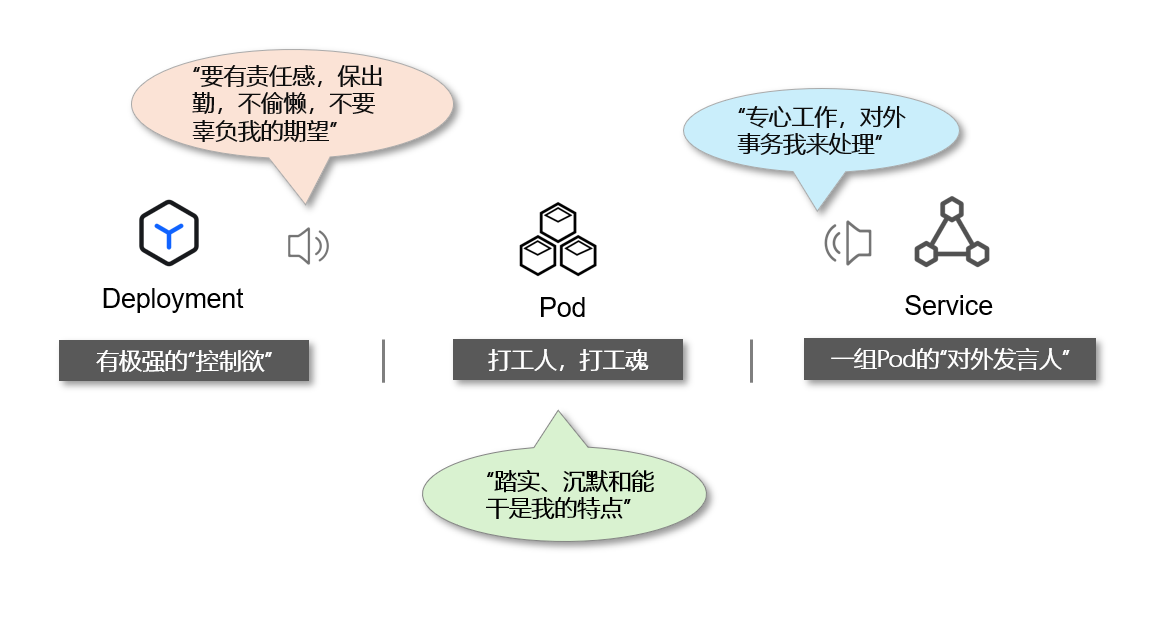
Pod 是牛马打工人,永远有负载运行。
Deployment 是创建Pod 和控制副本数的对象,Pod 要岁时随刻满足它的期望状态。所以它就是纪律管理员,Pod数量永远要保证出勤和数量。可以说它天生有强烈的控制欲望。
对于Service服务,它既是一组pod 的流量入口,也是对外发布信息的"网关"。就好比酒店大堂的总接待人。具体任务过来,它会分配给后端某个具体的Pod。
二、Pod、Deployment和Service的Spec配置
Kubernetes 的核心设计思想是 "声明式 API":用户通过 YAML 声明资源应该达到的状态。
所有资源(如 Pod、Deployment、Service、ConfigMap 等)的 YAML 配置中,spec是核心字段之一,定义了资源的 "期望"状态。
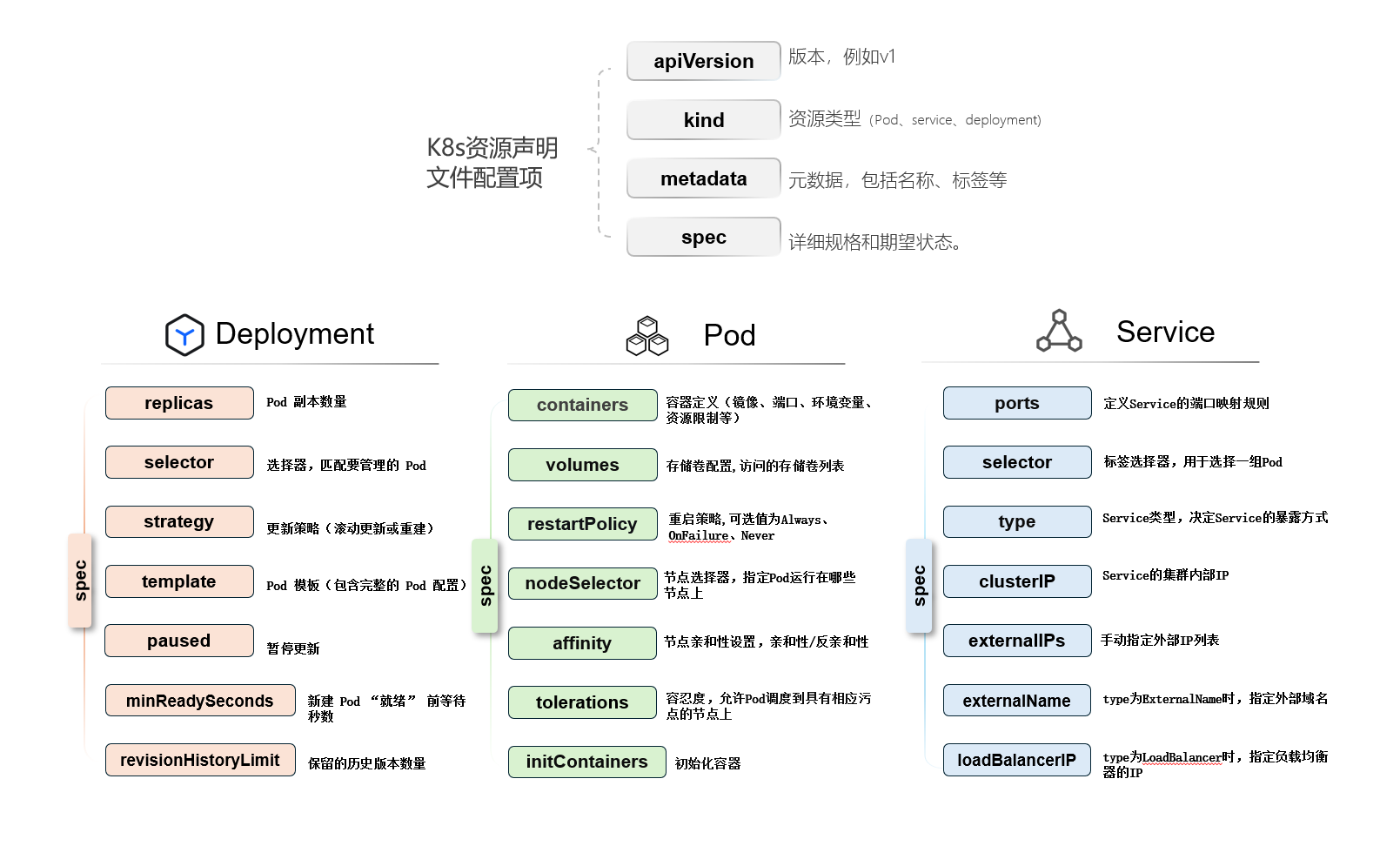
以上三种资源最重要的定义部分,都罗列到这张图里了,记得收藏哦!
2.1 Pod中spec定义部分
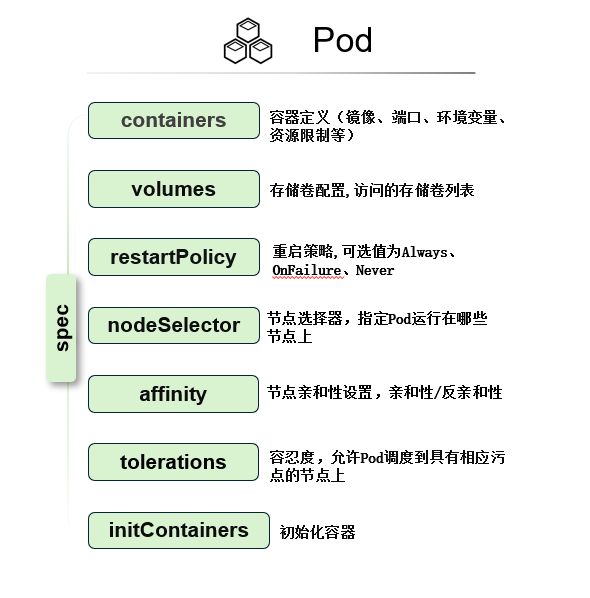
Pod的完整示例:
bash
apiVersion: v1
kind: Pod
metadata:
name: production-web-app
labels:
app: web-app
tier: frontend
version: v1.2.3
annotations:
kubernetes.io/change-cause: "Deploy version v1.2.3 with security fixes"
prometheus.io/scrape: "true"
prometheus.io/port: "8080"
spec:
# 调度配置
nodeSelector:
node-type: optimized-web
affinity:
podAntiAffinity:
requiredDuringSchedulingIgnoredDuringExecution:
- labelSelector:
matchExpressions:
- key: app
operator: In
values:
- web-app
topologyKey: kubernetes.io/hostname
# 安全配置
serviceAccountName: web-app-sa
securityContext:
runAsUser: 1001
runAsGroup: 1001
fsGroup: 1001
runAsNonRoot: true
seccompProfile:
type: RuntimeDefault
# 存储配置
volumes:
- name: app-config
configMap:
name: web-app-config
defaultMode: 0644
- name: tmp-volume
emptyDir:
medium: Memory
sizeLimit: 128Mi
- name: tls-secrets
secret:
secretName: web-app-tls
defaultMode: 0600
# 初始化容器
initContainers:
- name: init-config
image: busybox:1.35
command: ['sh', '-c', 'echo "Waiting for config..." && until [ -f /etc/config/ready ]; do sleep 2; done']
volumeMounts:
- name: app-config
mountPath: /etc/config
securityContext:
runAsUser: 1001
allowPrivilegeEscalation: false
# 主容器
containers:
- name: web-app
image: my-registry/app/web:v1.2.3
imagePullPolicy: IfNotPresent
# 资源限制
resources:
requests:
cpu: 500m
memory: 512Mi
ephemeral-storage: 1Gi
limits:
cpu: 1000m
memory: 1024Mi
ephemeral-storage: 2Gi
# 端口配置
ports:
- name: http
containerPort: 8080
protocol: TCP
- name: metrics
containerPort: 9090
protocol: TCP
# 环境变量
env:
- name: APP_ENV
value: "production"
- name: LOG_LEVEL
value: "info"
- name: CONFIG_PATH
value: "/etc/app/config"
- name: NODE_NAME
valueFrom:
fieldRef:
fieldPath: spec.nodeName
- name: POD_IP
valueFrom:
fieldRef:
fieldPath: status.podIP
# 健康检查
livenessProbe:
httpGet:
path: /healthz
port: 8080
httpHeaders:
- name: X-Health-Check
value: "liveness"
initialDelaySeconds: 45
timeoutSeconds: 3
periodSeconds: 10
failureThreshold: 3
readinessProbe:
httpGet:
path: /readyz
port: 8080
initialDelaySeconds: 5
timeoutSeconds: 2
periodSeconds: 5
successThreshold: 1
failureThreshold: 2
startupProbe:
httpGet:
path: /healthz
port: 8080
failureThreshold: 30
periodSeconds: 10
# 生命周期钩子
lifecycle:
postStart:
exec:
command:
- "/bin/sh"
- "-c"
- |
echo "Pod $POD_NAME started on $NODE_NAME" > /tmp/startup.log
preStop:
httpGet:
path: /prestop
port: 8080
# 存储挂载
volumeMounts:
- name: app-config
mountPath: /etc/app/config
readOnly: true
- name: tmp-volume
mountPath: /tmp
- name: tls-secrets
mountPath: /etc/tls
readOnly: true
# 容器安全上下文
securityContext:
allowPrivilegeEscalation: false
runAsNonRoot: true
runAsUser: 1001
capabilities:
drop:
- ALL
readOnlyRootFilesystem: true
# Pod 级别配置
restartPolicy: Always
terminationGracePeriodSeconds: 60
dnsPolicy: ClusterFirst
hostNetwork: false
hostPID: false
hostIPC: false
imagePullSecrets:
- name: registry-credentials2.2 Deployment中spec定义部分
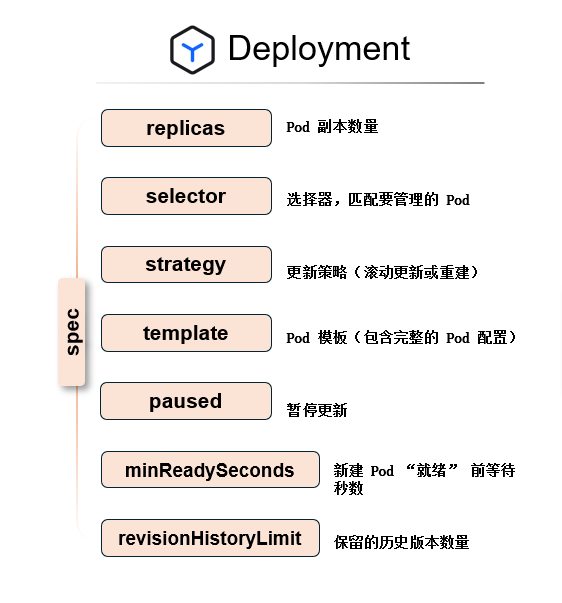
以下是一个包含上述主要配置的 Deployment 完整 YAML:
bash
apiVersion: apps/v1
kind: Deployment
metadata:
name: nginx-deployment
spec:
replicas: 3
selector:
matchLabels:
app: nginx
strategy:
type: RollingUpdate
rollingUpdate:
maxSurge: 1
maxUnavailable: 0
minReadySeconds: 5
revisionHistoryLimit: 5
template:
metadata:
labels:
app: nginx
spec:
containers:
- name: nginx
image: nginx:1.21
ports:
- containerPort: 80
resources:
requests:
cpu: "100m"
memory: "128Mi"
limits:
cpu: "200m"
memory: "256Mi"2.3 Service的spec定义部分
Kubernetes 中 Service 是 将运行在一个或一组 Pod 上的网络应用程序公开为网络服务的方法。
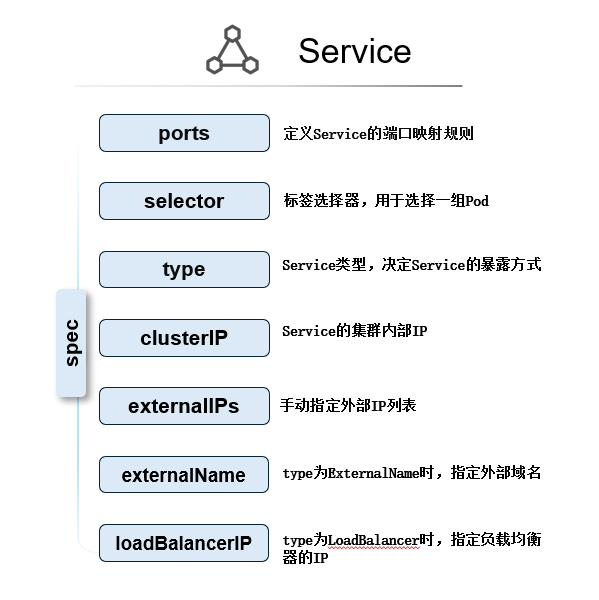
以下是一个包含上述主要配置的service完整yaml:
bash
apiVersion: v1
kind: Service
metadata:
name: production-web-service
namespace: web-production
labels:
app: web-application
environment: production
annotations:
# 云厂商特定注解
service.beta.kubernetes.io/aws-load-balancer-type: "nlb"
service.beta.kubernetes.io/aws-load-balancer-cross-zone-load-balancing-enabled: "true"
service.beta.kubernetes.io/aws-load-balancer-ssl-cert: "arn:aws:acm:us-west-2:123456789012:certificate/xxxxxx"
# 运维相关注解
prometheus.io/scrape: "true"
prometheus.io/port: "9090"
spec:
# 服务类型配置
type: LoadBalancer
# 选择器 - 关联后端 Pod
selector:
app: web-frontend
component: api-server
environment: production
version: v2.1.3
# 端口映射配置
ports:
- name: http-web
protocol: TCP
port: 80
targetPort: 8080
appProtocol: http
- name: https-web
protocol: TCP
port: 443
targetPort: 8443
appProtocol: https
- name: metrics
protocol: TCP
port: 9090
targetPort: 9090
appProtocol: http # 指标端点通常使用 HTTP
- name: grpc-api
protocol: TCP
port: 50051
targetPort: 50051
appProtocol: grpc
# IP 地址配置
clusterIP: 10.96.105.150 # 固定 ClusterIP,便于防火墙规则
loadBalancerIP: 203.0.113.25 # 预留的负载均衡器 IP
# 外部 IP(用于混合云或特定网络场景)
externalIPs:
- 192.168.1.200
- 192.168.1.201
# 会话保持配置
sessionAffinity: ClientIP
sessionAffinityConfig:
clientIP:
timeoutSeconds: 10800 # 3小时会话保持
# 流量策略
externalTrafficPolicy: Local # 保留客户端源 IP,流量只路由到本地节点 Pod
internalTrafficPolicy: Cluster # 内部流量在集群内所有 Pod 间负载均衡
# 健康检查配置(NodePort 类型相关)
healthCheckNodePort: 32456 # 自定义健康检查端口
# 负载均衡器源范围限制
loadBalancerSourceRanges:
- 203.0.113.0/24
- 198.51.100.0/24
- 192.168.0.0/16三、Statefulset、DaemonSet和Job深入理解
3.1 StatefulSet的Spec配置项
StatefulSet 运行一组 Pod,并为每个 Pod 保留一个稳定的标识。 这可用于管理需要持久化存储或稳定、唯一网络标识的应用。
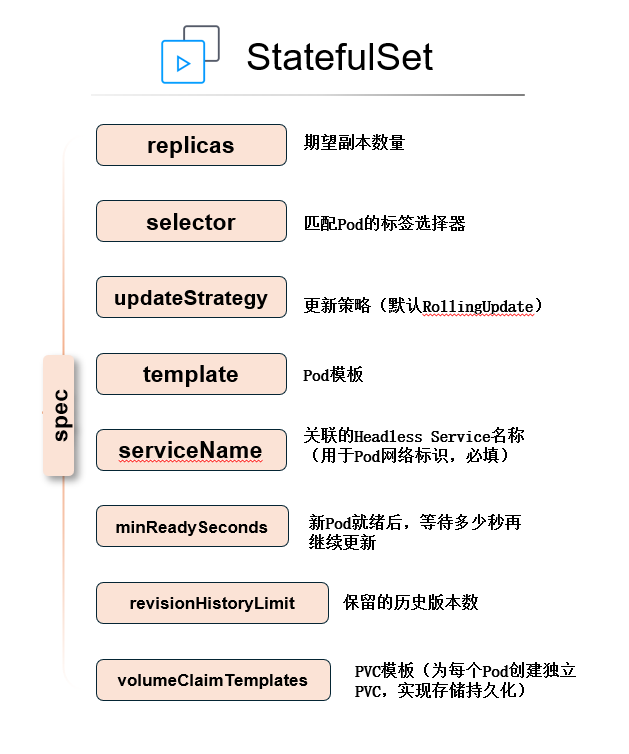
StatefulSet 用于管理有状态应用,spec 核心字段围绕 "稳定标识""有序部署 / 更新"、"存储持久化" 设计。
bash
spec:
replicas: <int> # 期望副本数(默认1)
selector: <LabelSelector> # 匹配Pod的标签选择器(必须与template.metadata.labels一致)
template: <PodTemplateSpec> # Pod模板(定义Pod的容器、网络、资源等)
serviceName: <string> # 关联的Headless Service名称(用于Pod网络标识,必填)
volumeClaimTemplates: <[]PersistentVolumeClaim> # PVC模板(为每个Pod创建独立PVC,实现存储持久化)
updateStrategy: # 更新策略(默认RollingUpdate)
type: <string> # 策略类型:RollingUpdate(滚动更新)/OnDelete(手动删除旧Pod才更新)
rollingUpdate: # 当type为RollingUpdate时生效
partition: <int> # 分区更新:仅更新序号≥partition的Pod(用于灰度发布)
revisionHistoryLimit: <int> # 保留的历史版本数(默认10,用于回滚)
minReadySeconds: <int> # 新Pod就绪后,等待多少秒再继续更新(默认0)StatefulSet 对于需要满足以下一个或多个需求的应用程序很有价值。
- 稳定的、唯一的网络标识符。
- 稳定的、持久的存储。
- 有序的、优雅的部署和扩缩。
- 有序的、自动的滚动更新。
3.2 DaemonSet的Spec配置项
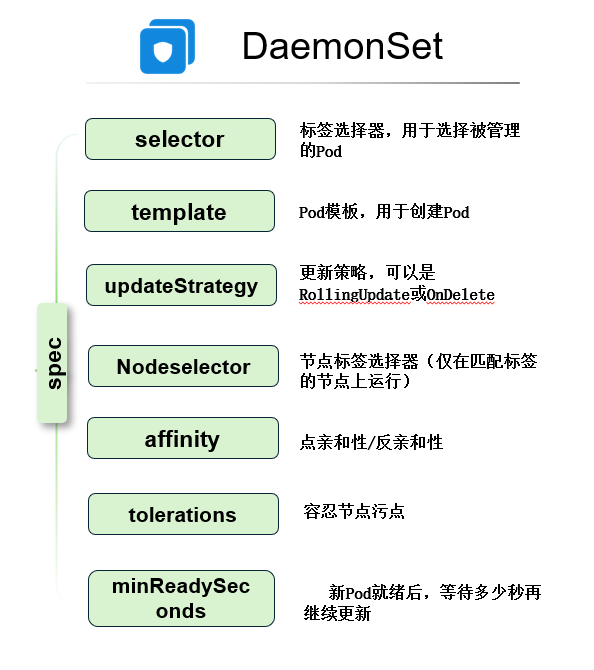
DaemonSet 用于在集群所有(或指定)节点上运行一个 Pod 副本。
bash
spec:
selector: <LabelSelector> # 匹配Pod的标签选择器(必须与template.metadata.labels一致)
template: <PodTemplateSpec> # Pod模板(定义要在节点上运行的容器)
updateStrategy: # 更新策略(默认RollingUpdate)
type: <string> # 策略类型:RollingUpdate(滚动更新)/OnDelete(手动删除旧Pod才更新)
rollingUpdate: # 当type为RollingUpdate时生效
maxUnavailable: <int/string> # 更新过程中允许不可用的最大Pod数(默认1,支持百分比如"20%")
minReadySeconds: <int> # 新Pod就绪后,等待多少秒再继续更新(默认0)
revisionHistoryLimit: <int> # 保留的历史版本数(默认10)
# 节点选择相关(控制DaemonSet在哪些节点上运行)
nodeSelector: <map[string]string> # 节点标签选择器(仅在匹配标签的节点上运行)
affinity: <Affinity> # 节点亲和性/反亲和性(更复杂的节点选择逻辑)
tolerations: <[]Toleration> # 容忍节点污点(允许在有污点的节点上运行,如master节点)需要强调的是:Spec核心字段围绕 "节点选择"、"更新策略" 设计。
3.3 Job的Spec配置项
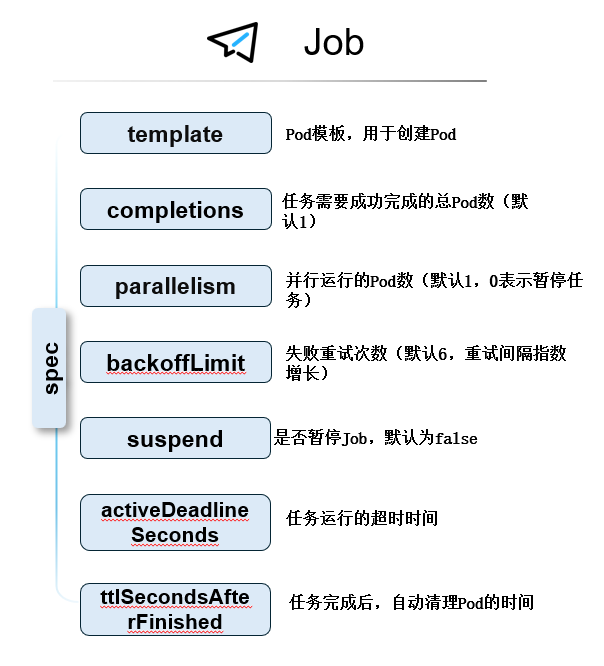
Job 用于运行一次性任务,Pod 成功完成后终止。
bash
spec:
parallelism: <int> # 并行运行的Pod数(默认1,0表示暂停任务)
completions: <int> # 任务需要成功完成的总Pod数(默认1)
activeDeadlineSeconds: <int> # 任务超时时间(超过此时长未完成则终止所有Pod,单位秒)
backoffLimit: <int> # 失败重试次数(默认6,重试间隔指数增长)
selector: <LabelSelector> # 匹配Pod的标签选择器(若手动指定Pod标签,需配置此选项)
manualSelector: <bool> # 是否允许手动指定selector(默认false,自动生成)
template: <PodTemplateSpec> # Pod模板(任务容器定义,需确保容器正常退出(exit 0))
ttlSecondsAfterFinished: <int> # 任务完成后,自动清理Pod的时间(单位秒,需开启TTLAfterFinished特性)需要注意的是spec核心字段是围绕 "任务完成条件""并行控制" 设计。
四、总结
核心差异点:
- StatefulSet 强调 serviceName 和 volumeClaimTemplates(有状态标识与持久化);
- DaemonSet 强调 nodeSelector/tolerations(节点选择);
- Job 强调 parallelism/completions(任务并行与完成条件);
- CronJob 强调 schedule/concurrencyPolicy(定时规则与并发控制)。
实际运维中,需结合业务场景(如无状态 / 有状态、常驻 / 一次性 / 定时任务)选择合适控制器,并合理配置上述spec字段。